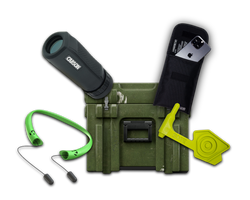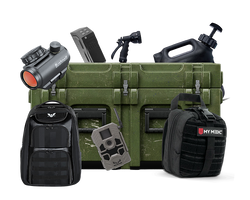How to Lube a Bolt Action Rifle: A Comprehensive Guide for Tactical Enthusiasts
Table of Contents
- Introduction
- Understanding Your Bolt Action Rifle
- How to Lube a Bolt Action Rifle: Step-by-Step Process
- Tips and Best Practices for Lubrication
- Common Mistakes to Avoid
- Conclusion
- FAQ
Introduction
Owning a bolt action rifle is not just about the thrill of shooting; it’s a commitment to maintaining precision, reliability, and performance. Did you know that a well-lubricated rifle can significantly enhance its lifespan and accuracy? Proper lubrication is essential for ensuring smooth operation, preventing corrosion, and maintaining the integrity of moving parts. Whether you are a seasoned marksman or a novice rifle owner, understanding how to lube a bolt action rifle effectively is crucial.
This blog post will delve into the importance of lubrication, the best practices for applying it, and the types of lubricants that work best for your rifle. We will explore the anatomy of a bolt action rifle and identify the key components that require lubrication. Moreover, we will discuss common mistakes to avoid and highlight the top products from Crate Club that can support your maintenance routine. By the end of this guide, you will be equipped with the knowledge to keep your bolt action rifle in peak condition.
The Importance of Lubrication
Lubrication plays a vital role in the functionality of any firearm, especially a bolt action rifle. Here’s why it matters:
- Reducing Friction: Lubricants minimize friction between moving parts, which can lead to wear and tear over time. This friction can cause malfunctions, leading to a frustrating shooting experience.
- Corrosion Resistance: Firearms are exposed to moisture and varying environmental conditions, making them susceptible to rust. Proper lubrication creates a barrier that helps prevent corrosion.
- Enhanced Performance: A well-lubricated rifle operates more smoothly, allowing for faster cycling of the bolt and quicker follow-up shots. This is especially important in tactical situations where every second counts.
Understanding Your Bolt Action Rifle
Before diving into the lubrication process, it’s essential to understand the anatomy of your bolt action rifle. Familiarizing yourself with its components will help identify areas that require lubrication.
Key Components of a Bolt Action Rifle
- Bolt: The primary mechanism that chambers rounds and ejects spent cartridges. It consists of several parts, including the bolt body, firing pin, extractor, and ejector.
- Receiver: The housing that contains the trigger mechanism and bolt assembly. It often requires lubrication to ensure smooth operation.
- Barrel: The part through which the bullet travels. While lubrication is not typically applied directly to the barrel, proper care is necessary for accuracy.
- Trigger Assembly: This mechanism needs to operate smoothly, requiring appropriate lubrication to avoid a heavy trigger pull.
- Stock: While not a mechanical component, ensuring the stock is free from moisture can help maintain overall integrity.
How to Lube a Bolt Action Rifle: Step-by-Step Process
Now that we’ve established the importance of lubrication and identified the key components, let’s dive into the step-by-step process of how to lube a bolt action rifle effectively.
Step 1: Gather Your Supplies
Before you begin, ensure you have the following supplies:
- High-quality gun lubricant or grease
- Cleaning patches or cloth
- A cleaning rod or brush
- A small, soft brush (like a toothbrush)
- Safety glasses (optional but recommended)
Step 2: Disassemble the Rifle
- Ensure Safety First: Before handling your rifle, always ensure it is unloaded. Check the chamber and magazine to confirm there are no live rounds.
- Remove the Bolt: Depending on your rifle model, this usually involves pulling the bolt back and pressing a release button. Refer to your user manual for specifics.
- Separate the Receiver from the Stock: Some rifles allow you to detach the stock from the receiver, which can make lubrication easier.
Step 3: Clean the Components
- Inspect for Dirt and Residue: Use the cleaning rod and patches to remove any dirt, carbon build-up, or old lubricant from the bolt and receiver.
- Use a Soft Brush: Gently scrub areas that are difficult to access, ensuring you remove all debris.
Step 4: Apply Lubricant
- Bolt: Apply a small amount of lubricant to the bolt body and the locking lugs. It’s crucial to use the correct amount; too much can attract dirt and debris.
- Receiver: Lubricate the receiver where the bolt contacts it. This area requires a light coat to ensure smooth operation.
- Trigger Assembly: Apply lubricant to pivot points and any moving parts within the trigger assembly. This will help maintain a crisp trigger pull.
- Check the Firing Pin: Ensure that the firing pin is also lightly oiled to prevent any sticking issues.
Step 5: Reassemble the Rifle
- Reattach the Bolt: Carefully reinsert the bolt into the receiver, ensuring it locks into place correctly.
- Reattach the Stock: If you removed the stock, reattach it securely to the receiver.
- Function Check: Cycle the bolt a few times to ensure everything operates smoothly. This step helps distribute the lubricant evenly.
Step 6: Final Inspection
- Inspect for Excess Lubricant: Wipe away any excess lubricant to prevent it from attracting dirt.
- Check Functionality: Ensure the rifle operates correctly by cycling the action and checking the trigger feel.
Tips and Best Practices for Lubrication
While the steps outlined above provide a solid framework for lubricating your bolt action rifle, here are some additional tips to keep in mind:
- Use the Right Products: Opt for high-quality lubricants specifically designed for firearms. Crate Club offers a range of tactical gear and maintenance products that can support your upkeep routine. Explore our Crate Club Shop for top-notch selections.
- Regular Maintenance: Make it a habit to lube your rifle regularly, especially after extensive use or exposure to harsh conditions.
- Avoid Common Mistakes: Over-lubrication can attract dirt, while under-lubrication can lead to malfunction. Always aim for a balanced approach.
Common Mistakes to Avoid
- Using Household Oils: Many enthusiasts mistakenly use household oils for lubrication. These products may not offer the necessary protection and can break down under heat or pressure.
- Neglecting the Trigger Assembly: It’s easy to overlook the trigger assembly, but this area is critical for optimal performance.
- Skipping Regular Maintenance: Over time, neglecting lubrication can lead to rust and malfunctions. Establish a routine to keep your rifle in top shape.
Conclusion
Understanding how to lube a bolt action rifle is essential for any gun owner dedicated to maintaining their firearm’s performance. By following the steps outlined in this guide, you can ensure your rifle operates smoothly and remains free from corrosion. Regular maintenance not only enhances performance but also extends the life of your firearm.
As a member of the Crate Club community, you can access an array of high-quality gear and maintenance tools to support your tactical needs. Consider subscribing to our Crate Club Subscription Services for monthly deliveries of curated tactical gear, survival tools, and more.
Remember, proper care is a reflection of your commitment to safety and performance. Take pride in your gear and ensure it’s always ready for action.
FAQ
How often should I lubricate my bolt action rifle?
The frequency of lubrication depends on usage. A good rule of thumb is to lube after every shooting session or at least once a month if the rifle is not in regular use.
Can I use motor oil to lubricate my rifle?
While motor oil may seem effective, it can break down under heat and pressure. It’s best to use products specifically designed for firearms to ensure optimal performance.
What type of lubricant is best for a bolt action rifle?
Look for high-quality gun oils or greases specifically formulated for firearm use. Brands that focus on tactical gear, like those available in the Crate Club Shop, often offer reliable options.
Is it necessary to clean the rifle before lubrication?
Yes, cleaning is crucial as it removes any debris, carbon build-up, or old lubricant that can interfere with the lubrication process.
Can over-lubrication damage my rifle?
Yes, excessive lubricant can attract dirt and grime, potentially leading to malfunctions. Always apply lubricant sparingly and wipe away any excess.
By mastering the art of lubrication, you ensure your bolt action rifle remains a trusted companion on your tactical adventures. Engage with the Crate Club community, share experiences, and continue honing your skills for optimal firearm care.
แบ่งปันบทความนี้



